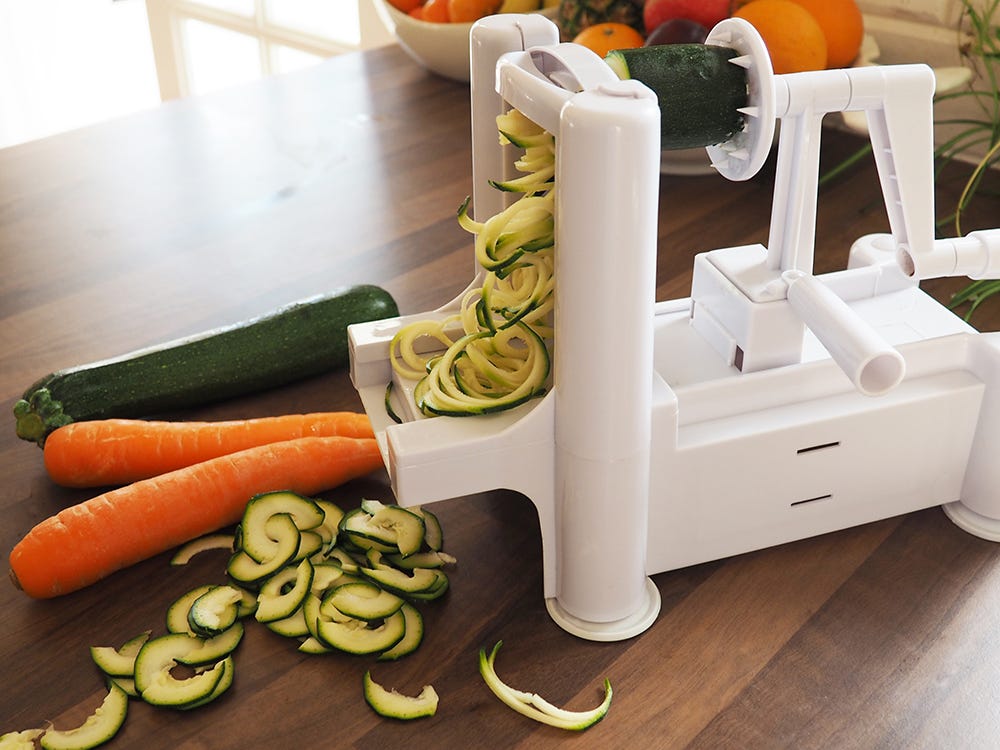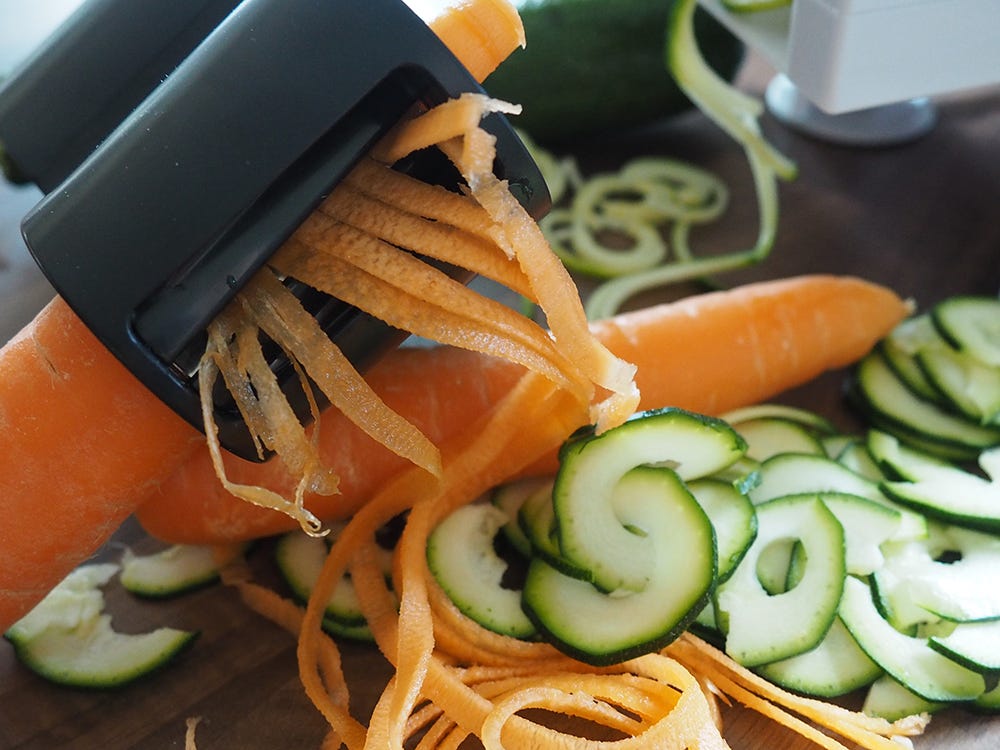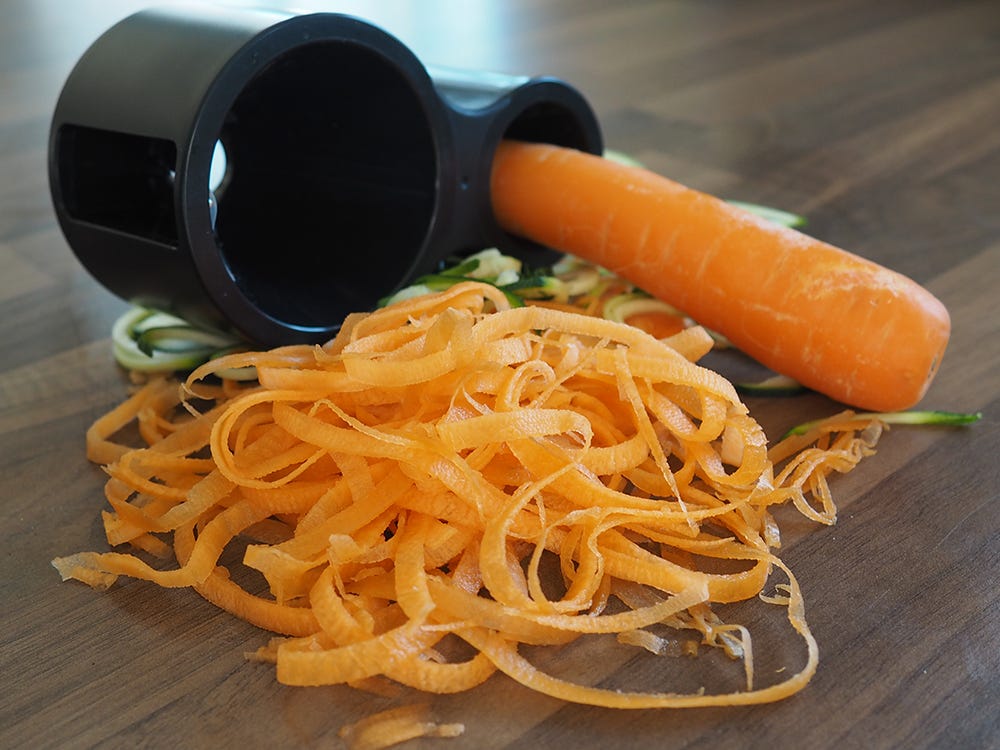A Beginner's Guide to Spiralizing
Categories:
Spiralizing has recently taken the world by storm and has quickly become one of the fastest healthy eating trends to emerge. Eating enough of the recommended fruit and vegetables in our diets can be even more challenging in modern times, due to factors including busy careers, juggling families and easy access to convenience foods. Spiralizing can make preparing healthy dishes quicker and easier and has also replaced the older method of using a julienne peeler to create longer ribbons and noodles from fresh vegetables. As a beginner it can seem a bit difficult to understand how spiralizing works, but the first thing you need is a spiralizer. A spiralizer works by manually rotating a vegetable or fruit on a spit style gadget against a series of different cutting blades to create different shreds.
- A slicing blade will cut long wide ribbons
- A small noodle blade will cut long spaghetti style noodles
- A large noodle blade will cut thicker noodles ideal for curly fries
Worktop spiralizers sit on your work surface and have a variety of blades, it will also have a turning handle which will have a small disc of spikes for pushing the vegetable or fruit onto, this will help hold the produce in place. This is then pushed up against the blade, the rotating of the handle will turn the vegetable or fruit onto the chosen blade and will start making the shredded produce. The suction on the base of the spiralizer will hold the unit steady whilst performing this action. Spiralizer attachments are available for some food mixers, which eliminate the need of having to turn the handle manually. You can check with the manufacturer of your kitchen food mixer to see if these are available. Once the fresh produce is collected, you can make either a healthy salad or coleslaw or a healthy bowl of vegetable noodles, approximately 300 calories less than the same bowl of pasta.  Handheld spiralizersact similar to pencil sharpeners, these work better with long thin fruits and vegetables. The fruit or vegetable pushes into the handheld spiralizer and is manually turned against the blade. This creates long spiral ribbons of fresh noodles. The handheld spiralizer is quick and easy to use if you just want to shred one food type, but if you are looking to make a salad with a large variety of vegetables then the worktop spiralizer is probably better for you. Knowing which vegetable or fruit to spiralize can be a little confusing, but really there is no right or wrong, longer thinner vegetables or fruits work a bit better because they are narrower than the blade diameter, whereas rounder vegetables and fruits can be wider than the blade cutting area and can end up catching around the edge and not cutting efficiently. The trick is to just try and see what you can create from spiralizing. But for a beginner, here are some ideas to get you started.
Handheld spiralizersact similar to pencil sharpeners, these work better with long thin fruits and vegetables. The fruit or vegetable pushes into the handheld spiralizer and is manually turned against the blade. This creates long spiral ribbons of fresh noodles. The handheld spiralizer is quick and easy to use if you just want to shred one food type, but if you are looking to make a salad with a large variety of vegetables then the worktop spiralizer is probably better for you. Knowing which vegetable or fruit to spiralize can be a little confusing, but really there is no right or wrong, longer thinner vegetables or fruits work a bit better because they are narrower than the blade diameter, whereas rounder vegetables and fruits can be wider than the blade cutting area and can end up catching around the edge and not cutting efficiently. The trick is to just try and see what you can create from spiralizing. But for a beginner, here are some ideas to get you started.
Courgette
Also known as a zucchini, a courgette is long and thin, for spiralizing though try to choose the straighter courgette as the curved ones are difficult to keep on the spiralizer. Remove the ends of the courgette and attach to the spikes one end and push up against the blade. Choose the smaller noodle blade and start turning. The courgette will turn into bowls and bowls of noodles, these can either be stir-fried or boiled gently for a few minutes to soften, or even eaten raw as part of a salad. 
Sweet Potato
Sweet potatoes can be used for making fries, so use the larger noodle blade for this one, this will created lots of curly fries that can either then be deep fried, air fried or baked. Alternatively use the smaller noodle blade for sweet potato noodles or after spiralizing the pieces can be blitzed in a processor to make rice for frying.
Beetroot
Beetroot is a great one for slicing on the spiralizer as this prevents dyeing the chopping board pink. Use the slicing blade for this one, this will create lots of long curly ribbons of colourful beetroot, perfect for a brightening up a summer salad or a tasty and healthy coleslaw. Alternatively you can use the noodle blade and make lovely long colourful beetroot spaghetti, great for a summer time.
Onions
No one likes chopping onions, which is great because you can do this with your spiralizer. You can use either the large noodle blade or the slicing blade for this, this will help the onion fall apart easily as it is cut. You can use your onion in the normal way for frying and cooking or using in salads. All onions, including red onions and shallots can be prepared in this way.
Apples
After taking out the stem and peeling you can use the slicing blade for curly slices of apple, ideal for a fruit salad or use either of the noodle blades for using in a fresh homemade coleslaw. If you are keeping the sliced apple for a while sprinkle with lemon juice to prevent it going brown. If you make apple noodles, you can lay them in a pastry base for baking an alternative apple pie.
Carrot
Carrot is one of the most versatile vegetables and can be used in so many ways. Once chopping off the ends, use the slicing blade for ribbons of carrot for a fresh and colourful salad. The two different sized noodle blades can be used for long and short noodles for a coleslaw or then can be blitzed in a processor for fried rice. Carrots are one of the best vegetables for being able to eat raw or cooked so there are many ways of spiralizing these. 
Broccoli
After trimming off all of the broccoli florets for cooking, there is no need to waste the stem, you can spiralize the stem to make fresh green broccoli noodles, packed full of nutrients. Trim down the stem and push onto the spiralizer, you will get long green noodles perfect for a quick pasta bowl, after boiling gently to soften. Spiralizing is a great way of exploring new things to do with vegetables and an even better way of getting children involved in preparing, eating their five a day and also using their imaginations, after all, what could be more fun than creating a giant bowl of wriggling worms?
